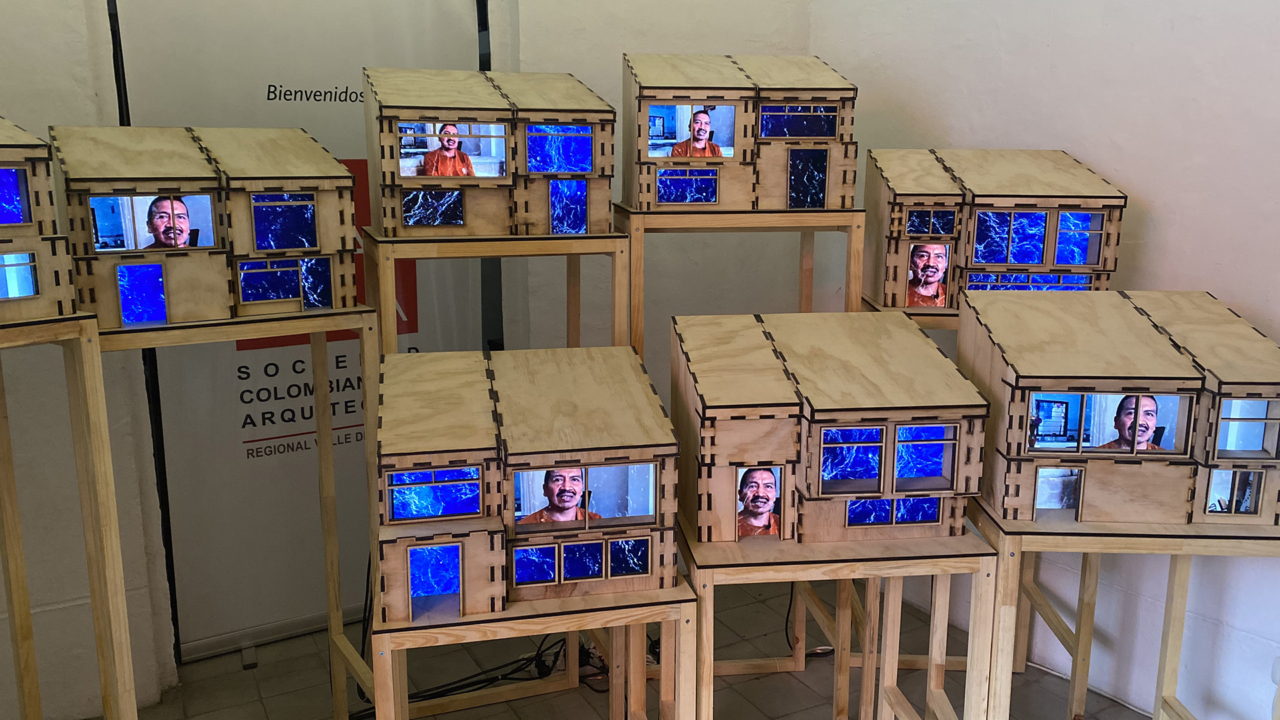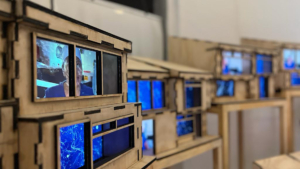- Posted on July 30th, 2025
imitating the dog – Navigating Global Reach with a Reduced Carbon Footprint

For Arts Council England and Julie’s Bicycle’s annual report 2023-24, we feature over 50 practical examples of cultural organisations taking climate action including in depth case studies like this one. Check out the full interactive report here.
This case study was written by imitating the dog – a touring theatre company. They outline their strategic shift to significantly reduce the carbon footprint of their international projects, detailing their decision-making process, a focus on minimising travel, and deeply collaborating with local artists and communities to create impactful work abroad while honouring their commitment to global cultural exchange.
About imitating the dog
imitating the dog (ITD) make ground-breaking work for theatres and other spaces. For 25 years our work has been seen across the world, at venues, and also at outdoor festivals and events, seen by hundreds of thousands of people.
We tell stories, creating beautiful, memorable images for audiences. The work is always fresh and often surprising.
Our most recent works include our 2024 theatre tour Frankenstein, video-exhibition installation The City Off the Map for The GREAT Project in Cali, Colombia and Follow Me Into, a collection of multi-building projection installations commissioned by the City of London for Bartholomew Fair 2023.
International Projects and Impacts
As the company began to plan the project The City Off the Map, we knew from previous years of measuring our environmental impact using Julie’s Bicycle’s tools, that the biggest slice of that pie chart by quite some margin was international travel – mostly flights taking company members to festivals and creative projects happening abroad. As we headed into the new year (April 2023), we knew we had to seriously address this by talking through the implications of sending fewer people out on international projects and to think creatively about how we could better balance out the demands of making excellent work, and our commitment to reducing imitating the dog’s carbon footprint.
There is no doubt that ITD has benefited enormously from making work with international partners and touring our productions across the world. We have enjoyed great relationships with international venues, festivals and promoters. Often with the support of the British Council, we’ve made projects in Italy, Greece and Singapore, and toured productions and delivered creative learning projects in Europe, and beyond; in Lebanon, Brazil, Taiwan and Chile. We have always found it an inspiring experience to meet artists and audiences wherever we’ve visited.
When ITD was commissioned by the GREAT Project (an international 3 year research project which explored the relationship between people and urban infrastructure) to make The City Off the Map, (or La ciudad fuera del mapa), we were excited by the opportunity to co-create an innovative digital installation which would be a tribute to the power of art and storytelling in shaping a people’s narrative. The work would be made and premiered in Cali, Colombia, co-produced with local artists, communities and researchers. It would then be exhibited in Lancaster, England.
Fundamentally, we believe that dialogue between countries should be free, and that we should be embracing cultural expression wherever our work takes us. Moreover, we understand that it is incumbent upon us to reach out and make international connections across the post-Brexit landscape. We cherish the wider world value of open networks of ideas, promoting the love and discussion of arts and culture, through artistic or educational exchange. How then to reconcile this with our commitment to reducing our carbon impact?
Assessing and Decision-Making
After reviewing annually our carbon footprint over a five year period, in late 2022 we had a discussion with our board about the pros and cons of international working, looking at the stark facts of their environmental impact. This discussion resulted in a checklist, a set of considerations, for any international projects we had on the horizon. We took time to think about and to note the reasons why we might elect to work internationally, but also the considerations of the cost to the planet. We then let this inform our decision-making process.
We decided that we will investigate opportunities to deliver additional creative engagement whilst working internationally: education / engagement / artist development wraparound activities. If a project is greenlit, we will consider all travel options: can we get there by road, ferry or rail? How do we minimise travel: number of personnel, freight, number of flights? We will seek and record additional opportunities whilst on the trip: artist development, making new connections with venues, engagement with communities outside of performances/installations, and, in the spirit of learning and the exchange of ideas, we will develop conversations with international partners around sustainability measures for the future.

On-the-Ground Connections and Collaboration
With The City Off the Map going ahead, we took the checklist in hand, and looked at the development opportunities the project offered. The opportunities were to deliver an exciting digital installation which could be exhibited both in Colombia and in the UK, working with new partners, and engaging with new communities of people to share learnings/ideas and to create work.
The project itself was about off-grid communities and sustainable cities, and we were keen to learn from them. We minimised flights – only 2 of the ITD team travelled – with the rest of the team working remotely. We engaged local artists in Cali to deliver the work on the ground when we weren’t physically there. We were able to find and engage with these artists through the connections we had with the University in Cali. As this was a joint project (the GREAT project), we were able to rely on good on-the-ground knowledge. Without those local connections, it would have been much more difficult to find local artists, venues, creative participants and so on. During the periods that our artists were in Colombia, they worked alongside the Cali-based artists, students, and members of the community. They delivered talks, took part in events and debates, and met with a wider community of makers.
How much international work we make in the future of course remains to be seen. Our thinking has certainly resulted in a step-change in our practice, and our commitments will ensure that we hold ourselves accountable, that we put sustainability at the forefront of our planning, alongside the development of the projects we choose to undertake.
Header image: The City Off the Map Installation: Credit: Natalia Valderrama
